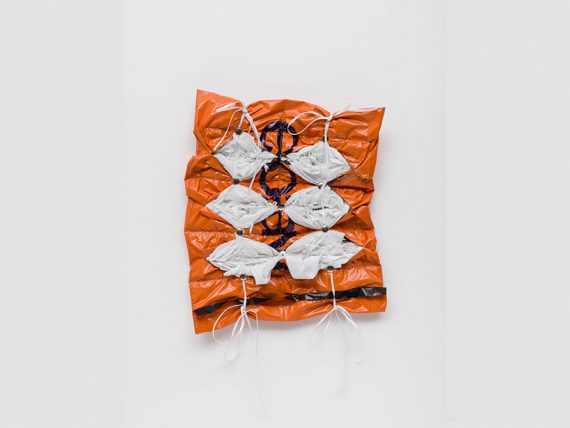
7 September - 21 October
In Ladder, Tenant of Culture presents a new body of work that examines the perceived dichotomy between destruction and decoration, interrogating how the aesthetic of waste has, for centuries, been appropriated within the fashion industry. These new wall-based and suspended works highlight the dissonance between the creation of physical waste and the aestheticization of damage.
In the exhibition, the artist expands her approach to undoing material, utilising traditional craft techniques based on the extraction or destruction of threads and fibres. These processes include devoré, open work embroidery and slicing as well as deconstructive methods developed through material experimentation to reference the practice in the garment industry of intentionally creating rips or slashes in previously undamaged clothing and accessories. The artificially ripped pair of jeans may be the most well-known contemporary example, but for centuries textile workers slashed garments as both a political act of resistance and a mechanism of control.
The cultural significance of the destruction of clothing is grounded in several notable moments in fashion’s industrial and stylistic history. The “cutters” movement of the mid 18th century utilised slashing as an act of protest, while the Spitalfields silk weavers engaged in campaigns of destroying each other’s work in a battle to stabilise wages. During the European Renaissance, the decorative technique of cutting slits in the outer layer of a garment to expose the fabric underneath was inspired by the distressed clothing of soldiers returning from battle, serving to visually distinguish political allegiances and social hierarchies. Today, the common approach of luxury brands is to slice unsold luxury goods to prevent value deflation; an economic strategy to create exclusivity through scarcity. Tenant of Culture explores this inheritance, disassembling and rebuilding manufactured garments to look at the politically charged treatment of textiles, examining the ways in which ideological frameworks with wide social implications materialise in methods of production, circulation and marketing of apparel.
The works in Ladder examine the complex relation between fashion trends and their manufacturing processes. They aim to confront the cognitive dissonance between our individual relationship with clothes versus the global system in which they are produced by offering multiple perspectives – between individual desire and industry, transparency and concealment, the brand new and the discarded.
The exhibition will be accompanied by a text from Eilidh Duffy, available as part of a free, limited edition oversize pamphlet.
